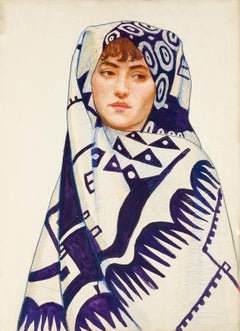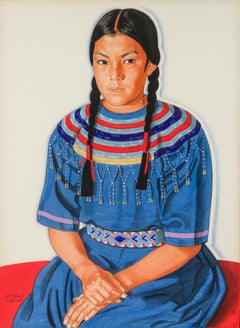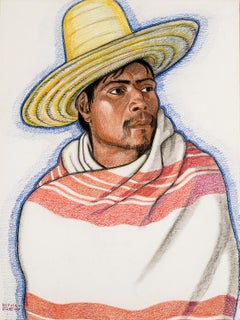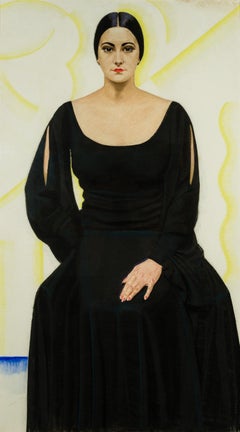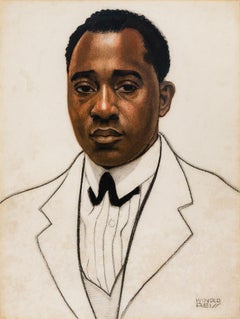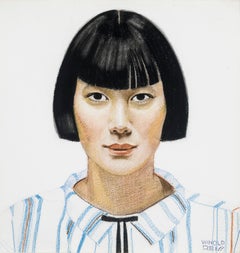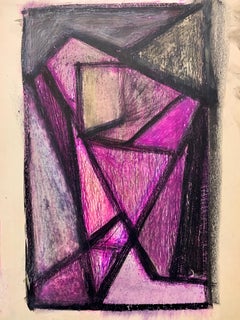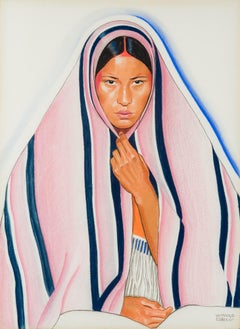Winold Reiss Portrait Drawings and Watercolors
American, 1886-1953
Winold Reiss was a German-American muralist and illustrator who is best remembered for his portraits of the Blackfoot Indian tribe. His work was so revered by the tribe that when he died, his ashes were spread across sacred burial grounds.
to
1
1
3
1
Overall Width
to
Overall Height
to
6
6
5
1
6
4
4
2
2
2
2
1
1
1
1
1
1
1
1
4
4
2
2
2
13
189
72
60
51
2
6
Artist: Winold Reiss
Girl in Decorative Wrap
By Winold Reiss
Located in New York, NY
Winold Reiss (1886-1953), who scholars increasingly recognize as a pivotal figure in early 20th-century American art, is known for his evocative portraits that capture the spirit and...
Category
20th Century American Modern Winold Reiss Portrait Drawings and Watercolors
Materials
Mixed Media, Board
Long Time River Woman (Blackfoot Maiden)
By Winold Reiss
Located in New York, NY
Winold Reiss (1886-1953), who scholars increasingly recognize as a pivotal figure in early 20th-century American art, is known for his evocative portraits that capture the spirit and...
Category
20th Century American Modern Winold Reiss Portrait Drawings and Watercolors
Materials
Paper, Mixed Media
Indian Man from Mexico
By Winold Reiss
Located in New York, NY
Indian Man from Mexico is a souvenir of Winold Reiss’s 1920 sketching tour of Mexico. As he traveled, Reiss’s style began to reflect the influence of the aesthetics, color palette, a...
Category
20th Century American Modern Winold Reiss Portrait Drawings and Watercolors
Materials
Paper, Pastel
Rosalee Sondheimer I
By Winold Reiss
Located in New York, NY
Winold Reiss (1886-1953), who scholars increasingly recognize as a pivotal figure in early 20th-century American art, is known for his evocative portraits that capture the spirit and...
Category
20th Century American Modern Winold Reiss Portrait Drawings and Watercolors
Materials
Pastel, Board
Portrait of Robert Nathaniel Dett (1882-1943)
By Winold Reiss
Located in New York, NY
Signed (at lower right): WINOLD/REISS
Category
20th Century American Modern Winold Reiss Portrait Drawings and Watercolors
Materials
Pastel
Price Upon Request
Japanese Girl
By Winold Reiss
Located in New York, NY
Signed (at lower right): WINOLD/REISS
Category
20th Century American Modern Winold Reiss Portrait Drawings and Watercolors
Materials
Pastel
Price Upon Request
Related Items
1950s "Purple Head" Mid Century Oil and Pastel Portrait Original Drawing
By Donald Stacy
Located in Arp, TX
Donald Stacy
"Purple Head"
c.1950s
Gouache and oil pastel on paper
13.75" x 17" unframed
Unsigned
Came from artist's estate
Donald Stacy (1925-2008) New Jersey
Studied: Newark School of Fine Art
The Art Students League
Pratt Graphic Arts Center
University of Paris 1953-54
University of Aix-en-Provence 1954-55
Faculty: Art Department of the New School
Museum of Modern Art
School of Visual Arts
Stacy Studio Workshop
Exhibitions: Grand Central Moderns
George Wittenborn
The New School
Print Exhibitions, Chicago
University of Oklahoma
Honolulu Museum
Monclair Museum
Wisconsin State College
Louisiana Art Commission
Philadelphia Print...
Category
Mid-20th Century American Modern Winold Reiss Portrait Drawings and Watercolors
Materials
Paper, Oil Pastel, Gouache
$570 Sale Price
40% Off
H 17 in W 13.75 in
A Fine 1930s Modern Figure Study Drawing of a Standing Young Male Nude Model
By Harold Haydon
Located in Chicago, IL
A Fine, 1930s Modern Academic Figure Study of a Standing Young Male Nude Model by Notable Chicago Artist, Harold Haydon (Am. 1909-1994). An exceptionally well executed early 1930s c...
Category
1930s American Modern Winold Reiss Portrait Drawings and Watercolors
Materials
Paper, Charcoal
$265
H 24 in W 18 in D 0.13 in
A Vintage Mid-Century Modern Portrait of a Young Man with Long Hair, Beatnik Era
By Harold Haydon
Located in Chicago, IL
A Vintage, Mid-Century Modern, Beatnik-era portrait study of a young male model with long hair by notable Chicago artist, Harold Haydon. The drawing is charcoal on paper dating circ...
Category
Mid-20th Century American Modern Winold Reiss Portrait Drawings and Watercolors
Materials
Paper, Charcoal
$165
H 16 in W 12 in D 0.13 in
A Fine 1946 Modern Figure Study of a Handsome Young Male Model Wearing a Suit
By Harold Haydon
Located in Chicago, IL
A Fine 1940s, Mid-Century Modern Academic Figure Study Portrait of a Handsome, Seated Male Model Wearing a Suit by Notable Chicago Artist, Harold Haydon (Am. 1909-1994). An exceptionally well executed early 1940s charcoal...
Category
Mid-20th Century American Modern Winold Reiss Portrait Drawings and Watercolors
Materials
Charcoal, Paper
$285
H 24 in W 18 in D 0.13 in
A Charming, Vintage 1930s Charcoal Drawing of a Saxophone Player, Jazz Musician
By Harold Haydon
Located in Chicago, IL
A Charming, Vintage 1930s Charcoal Drawing of a Saxophone Player, Jazz Musician, by Notable Chicago Modern Artist, Harold Haydon (Am. 1909-1994). A striking and lively figure study ...
Category
1930s American Modern Winold Reiss Portrait Drawings and Watercolors
Materials
Paper, Charcoal
$285
H 24 in W 18 in D 0.13 in
A Handsome 1940s Portrait of a Seated Man by Chicago Artist, Harold Haydon
By Harold Haydon
Located in Chicago, IL
A Handsome 1940s Portrait of a Seated Man by Chicago Modern Artist, Harold Haydon (Am. 1909-1994). A wonderfully executed line drawing dating from 1946 with great character; looks ...
Category
Mid-20th Century American Modern Winold Reiss Portrait Drawings and Watercolors
Materials
Paper, Graphite
$135
H 20 in W 16 in D 0.13 in
Modern Dancers
By Mick Micheyl
Located in London, GB
'Modern Dancers', pastel, ink and gouache on fine art paper by French artist, singer and sculptor, Mick Micheyl (1964). Two elegant young men are depicted in a graceful dancing pose, arms outstretched, their lithe bodies so agile and limber. Perhaps one of the dancers was her friend, Philippe, to whom the painting is dedicated on the bottom. The dedication says: 'For you Philippe, all my friendship'. Signed: 'Mick Micheyl'. The work has been newly framed and glazed after having been acquired in the S. of France. It is in fair vintage condition commensurate with age showing minor blemishing on the paper. Upon request a video of the piece can be provided.
Dimensions with Frame:
H 75 cm / 29.5"
W 61 cm / 24"
Dimensions without Frame:
H 56 cm / 22"
W 42 cm / 16.5"
About the Artist: Mick Micheyl (1922 - 2019) was born in Lyon and had a busy and rewarding artistic career as a singer, producer, reviewer, metal sculptor, artist. After having received training at the School of Fine Arts in Lyon she became a painter and decorator in the theatre but then commenced a career in the musical activities of a theatrical troupe. She won the ABC competition in Paris in 1949 with a song, Le Marchand de Poésie, which she composed herself. She then performed in many cabarets: L'Échelle de Jacob, Harlequin and Liberty's. In the 1950s she was one of the most important French cabaret singers of that period. One of her titles, 'Un Gamin de Paris', became one of the French standards and also performed by Yves Montand and Robert Clary...
Category
1960s Modern Winold Reiss Portrait Drawings and Watercolors
Materials
Paper, Pastel, Ink, Gouache
African Mama - Vintage Illustration in Ink and Watercolor
By Irene Pattinson
Located in Soquel, CA
African Mama - Vintage Illustration in Ink and Watercolor
A charming illustration, by Irene Pattinson (American, 1909-1999), shows a woman with a...
Category
1950s American Modern Winold Reiss Portrait Drawings and Watercolors
Materials
Paper, India Ink, Watercolor, Pen
$636 Sale Price
20% Off
H 13 in W 10 in D 0.25 in
Rare Modernist Hungarian Rabbi Pastel Drawing Gouache Painting Judaica Art Deco
By Hugó Scheiber
Located in Surfside, FL
Rabbi in the synagogue at prayer wearing tallit and tefillin.
Hugó Scheiber (born 29 September 1873 in Budapest – died there 7 March 1950) was a Hungarian modernist painter.
Hugo Scheiber was brought from Budapest to Vienna at the age of eight where his father worked as a sign painter for the Prater Theater. At fifteen, he returned with his family to Budapest and began working during the day to help support them and attending painting classes at the School of Design in the evening, where Henrik Papp was one of his teachers. He completed his studies in 1900. His work was at first in a post-Impressionistic style but from 1910 onward showed his increasing interest in German Expressionism and Futurism. This made it of little interest to the conservative Hungarian art establishment.
However, in 1915 he met the great Italian avant-gardist Filippo Tommaso Marinetti and the two painters became close friends. Marinetti invited him to join the Futurist Movement. The uniquely modernist style that he developed was, however, closer to German Expressionism than to Futurism and eventually drifted toward an international art deco manner similar to Erté's. In 1919, he and his friend Béla Kádar held an exhibition at the Hevesy Salon in Vienna. It was a great success and at last caused the Budapest Art Museum to acquire some of Scheiber's drawings. Encouraged, Scheiber came back to live in Vienna in 1920.
A turning point in Scheiber's career came a year later, when Herwarth Walden, founder of Germany's leading avant-garde periodical, Der Sturm, and of the Sturm Gallery in Berlin, became interested in Scheiber's work. Scheiber moved to Berlin in 1922, and his paintings soon appeared regularly in Walden's magazine and elsewhere. Exhibitions of his work followed in London, Rome, La Paz, and New York.
Scheiber's move to Germany coincided with a significant exodus of Hungarian artists to Berlin, including Laszlo Moholy-Nagy and Sandor Bortnyik. There had been a major split in ideology among the Hungarian avant-garde. The Constructivist and leader of the Hungarian avantgarde, Lajos Kassák (painted by Hugó Scheiber in 1930) believed that art should relate to all the needs of contemporary humankind. Thus he refused to compromise the purity of his style to reflect the demands of either the ruling class or socialists and communists. The other camp believed that an artist should be a figurehead for social and political change.
The fall out and factions that resulted from this politicisation resulted in most of the Hungarian avant gardists leaving Vienna for Berlin. Hungarian émigrés made up one of the largest minority groups in the German capital and the influx of their painters had a significant effect on Hungarian and international art. Another turning point of Scheiber's career came in 1926, with the New York exhibition of the Société Anonyme, organized by Katherine Dreier. Scheiber and other important avant garde artists from more than twenty-three countries were represented. In 1933, Scheiber was invited by Marinetti to participate in the great meeting of the Futurists held in Rome in late April 1933, Mostra Nazionale d’Arte Futurista where he was received with great enthusiasm. Gradually, the Hungarian artists began to return home, particularly with the rise of Nazism in Germany. Kádar went back from Berlin in about 1932 and Scheiber followed in 1934.
He was then at the peak of his powers and had a special flair in depicting café and cabaret life in vivid colors, sturdily abstracted forms and spontaneous brush strokes. Scheiber depicted cosmopolitan modern life using stylized shapes and expressive colors. His preferred subjects were cabaret and street scenes, jazz musicians, flappers, and a series of self-portraits (usually with a cigar). his principal media being gouache and oil. He was a member of the prestigious New Society of Artists (KUT—Képzőművészek Új Társasága)and seems to have weathered Hungary's post–World War II transition to state-communism without difficulty. He continued to be well regarded, eventually even receiving the posthumous honor of having one of his images used for a Russian Soviet postage stamp (see image above). Hugó Scheiber died in Budapest in 1950.
Paintings by Hugó Scheiber form part of permanent museum collections in Budapest (Hungarian National Museum), Pecs (Jannus Pannonius Museum), Vienna, New York, Bern and elsewhere. His work has also been shown in many important exhibitions, including:
"The Nell Walden Collection," Kunsthaus Zürich (1945)
"Collection of the Société Anonyme," Yale University Art Gallery, New Haven, Connecticut (1950)
"Hugó Scheiber: A Commemorative Exhibition," Hungarian National Museum, Budapest (1964)
"Ungarische Avantgarde," Galleria del Levante, Munich (1971)
"Paris-Berlin 1900-1930," Centre Georges Pompidou, Paris (1978)
"L’Art en Hongrie, 1905-1920," Musée d’Art et l’Industrie, Saint-Etienne (1980)
"Ungarische Avantgarde in der Weimarer Republik," Marburg (1986)
"Modernizmus," Eresz & Maklary Gallery, Budapest (2006)
"Hugó Scheiber & Béla Kádár," Galerie le Minotaure, Paris and Tel Aviv (2007)
Hugó Scheiber's paintings continue to be regularly sold at Sotheby's, Christie's, Gillen's Arts (London), Papillon Gallery (Los Angeles) and other auction houses.
He was included in the exhibition The Art Of Modern Hungary 1931 and other exhibitions along with Vilmos Novak Aba, Count Julius Batthyany, Pal Bor, Bela Buky, Denes Csanky, Istvan Csok, Bela Czobel, Peter Di Gabor, Bela Ivanyi Grunwald, Baron Ferenc Hatvany, Lipot Herman, Odon Marffy, C. Pal Molnar...
Category
Early 20th Century Modern Winold Reiss Portrait Drawings and Watercolors
Materials
Paper, Charcoal, Pastel, Watercolor, Gouache
$5,500
H 15.75 in W 14.5 in
La femme aux fleurs (Portrait de Mathilde See)
By Paul César Helleu
Located in New Orleans, LA
Paul César Helleu is regarded among the most sought-after society portraitists of his era, and his Belle Époque works rival those of his contemporaries John Singer Sargent and Giovanni Boldini. He is best remembered for capturing the era's most beautiful socialites, including Consuelo Vanderbilt, the Duchess of Marlborough, the Comtesse de Loriol Chandieu and the Comtesse Mathieu de Noailles, among others. This work, however, stands out in that it captures the charming likeness of one of his art world cohorts, Mathilde See, a Parisian-born decorator and painter of floral still lifes. She is the essence of the modern woman, captured in her fashionable dress as she strolls along the flower-lined streets of Paris.
Commanding in size, Portrait de Mathilde See fully displays Helleu's mastery over the medium of pastel. The muted palette of greys and blues is typical of the artist, bringing a harmony and cohesiveness to the composition. Furthermore, Helleu cleverly alludes to See's own artistic output with a backdrop of vibrant floral blooms, enlivening the canvas and complementing the greens and blues of the peacock feather adorning her hat.
The portrait is all the more significant thanks to its provenance. It was previously in the collection of A. Alfred Taubman, one of America's most successful entrepreneurs and one-time owner of Sotheby's. Considering Taubman encountered some of the most noteworthy and beautiful works of art ever made through his auction house, the fact that he chose this portrait by Helleu to grace his collection is a testament to its import.
Born in Brittany in 1859, Helleu moved to Paris in 1876 in order to study at the École des Beaux-Arts. Like so many other artists of his generation, he was trained there under the Academic master Jean-Léon Gérôme. That same year, he also attended the Second Impressionist Exhibition...
Category
20th Century Modern Winold Reiss Portrait Drawings and Watercolors
Materials
Linen, Pastel
$425,000
H 61.38 in W 48.25 in
Alfred Bendiner, Johnny Hodges (Johnny Hodges, Bass Fiddle & Traps)
By Alfred Bendiner
Located in New York, NY
Did Bendiner ever miss a performance, show, concert, play? Was there anyone he didn't know?
This double-side drawing in blue crayon shows Johnny Hodges (jazz saxophonist extraordina...
Category
1950s American Modern Winold Reiss Portrait Drawings and Watercolors
Materials
Crayon
A Delightful 1930s Portrait Sketch of a Young Boy in a Baseball Cap
By Harold Haydon
Located in Chicago, IL
A Delightful, 1930s Portrait Sketch of a Young Boy in a Baseball Cap by Noted Chicago Modern Artist, Harold Haydon (Am. 1909-1994). Full of Character! A charming little gem of a po...
Category
1930s American Modern Winold Reiss Portrait Drawings and Watercolors
Materials
Paper, Charcoal
$85
H 8.25 in W 8.75 in D 0.13 in
Previously Available Items
Natokiochkome (Howling Twice)
By Winold Reiss
Located in New York, NY
Winold Reiss (1886-1953), who scholars increasingly recognize as a pivotal figure in early 20th-century American art, is known for his evocative portraits that capture the spirit and...
Category
20th Century American Modern Winold Reiss Portrait Drawings and Watercolors
Materials
Paper, Mixed Media
Winold Reiss portrait drawings and watercolors for sale on 1stDibs.
Find a wide variety of authentic Winold Reiss portrait drawings and watercolors available for sale on 1stDibs. You can also browse by medium to find art by Winold Reiss in crayon, pastel and more. Much of the original work by this artist or collective was created during the 20th century and is mostly associated with the modern style. Not every interior allows for large Winold Reiss portrait drawings and watercolors, so small editions measuring 15 inches across are available. Customers who are interested in this artist might also find the work of Albert Al Hirschfeld, Alfred Bendiner, and Ivan Chermayeff.
